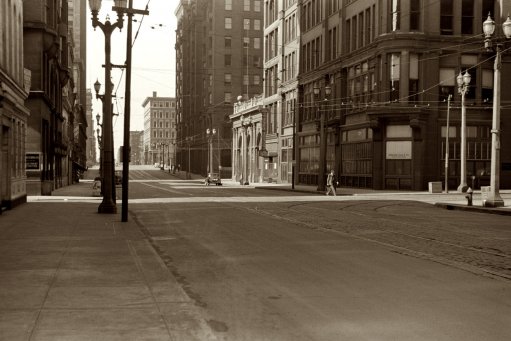On the Road: Pittsburgh, Pennsylvania
Click on Thumbnail for MapUnfolding the Map
Sal reaches the city at the conjunction of two rivers that combine to form a mighty third. He's out of money. To get home from here, he'll have go back to hitching and waiting for a friendly ride. To see where we are, click on the map.
Book Quote
"...and I slept all the way to Pittsburgh. I was wearier than I'd been for years and years."
On the Road, Chapter 14
 Downtown Pittsburgh in the 1940s as Jack Kerouac would have seen it
Downtown Pittsburgh in the 1940s as Jack Kerouac would have seen it
Pittsburgh, Pennsylvania
Pittsburgh is one of those cities I've always wished I visited, but haven't. Most people that I've met that are from Pittsburgh, or lived there for a while, really like it. I think of it as one of those mid-sized northern cities, like Milwaukee where I once lived, that holds on to its blue-collar identity despite the demise of the blue-collar economy because that's what made it strong and put it on the map.
I remember when I was young, watching the Pittsburgh Steelers win Super Bowl after Super Bowl. The television sports announcers would extoll the hard working, industrial image of the Steelers with monikers like their "Steel Curtain" defense, and I grew to hate them with a grudging respect for their accomplishments. Of course, I knew the nickname attached to Pittsburgh, the "Steel City." But I was more intrigued by the name of their former football stadium, Three Rivers Stadium. I liked the image of three rivers coming together. I had no idea what those rivers were, but growing up on the coast of California and spending a lot of my summers 20 miles inland, swimming in a river that ran through some property we owned, I felt an attachment to rivers. I liked walking up or down them, learning what new features could be found with every bend or curve.
I think of Sal, coming to the city defined and delineated by three rivers, which I have learned somewhere in my adult life are the Monongahela and the Allegheny which combine to form the Ohio. As I wrote in a previous post about the Hudson, rivers are representative of pathways to new places or even for escape. I think of Huck Finn rafting down the Mississippi, or Lewis and Clark using the Missouri River to make their way into unexplored territories. Even escaping prisoners often make for rivers to follow in the hopes that tracks will be washed away and scent concealed. I was always told, when hiking alone in the mountains as a youth out at our property at Irmulco, California, that if I got lost and I found a stream or streambed, follow it down and continue to work my way along the water until I found someone or something to get my bearings. I put this advice to use once, and it worked perfectly, bringing me back to the railroad tracks that got me back to our property.
But rivers are also boundaries, borders, and barriers. The Greek myths place the River Styx at the boundary to Hades, where the boatman Charon ferries souls across to the afterlife. In history, before it was possible to build bridges across large rivers, they presented significant obstacles to the movement of peoples and armies. Even in the age of bridges and ease of travel, rivers can wash out crossings, flood their banks and create difficulties in getting from place to place. In going home to see my mom during the winter holidays, I often end up staying longer than I intended because the rivers flood and roads are closed until they recede.
Perhaps I'm making more out of Sal's Pittsburgh stop than need be. After all, it's the farthest he could get on the bus with the money he had. But it seems symbolic nonetheless. If he truly is weary, the confluence of two large rivers to create an even mightier third symbolizes a new strength and vitality. It is also a boundary, where his bus ride ends and where he now has to rely on his ability to persuade others to take him the rest of the way. Rivers continue to flow to their end, time moves on, and Sal's journey will continue through time and space back to Paterson.
If you want to know more about Pittsburgh
BurghFeeding
Burghilicious
Digging Pitt
Eat PGH
Foodburgh
I Heart PGH blog
Pittsburgh Bloggers
Pittsburgh City Paper (Alternative newsweekly
Pittsburgh Green Story: America's Three Rivers
Pittsburgh Point of View
Pittsburgh Post-Gazette (Newspaper)
Three Rivers Arts Festival
View from the Burghchair
Wikipedia: Pittsburgh
Next up: Harrisburg, Pennsylvania
 Jack Kerouac,
Jack Kerouac,  On the Road,
On the Road,  Pennsylvania,
Pennsylvania,  Pittsburgh,
Pittsburgh,  Sal Paradise,
Sal Paradise,  beat,
beat,  beatnik,
beatnik,  bus,
bus,  bus travel in
bus travel in  On the Road
On the Road 







